This article originally appeared in the Smithsonian's Folklife Magazine, as part of the series "A Stream of Voices" co-presented by the Endangered Languages Project and the Smithsonian Center for Folklife and Cultural Heritage.
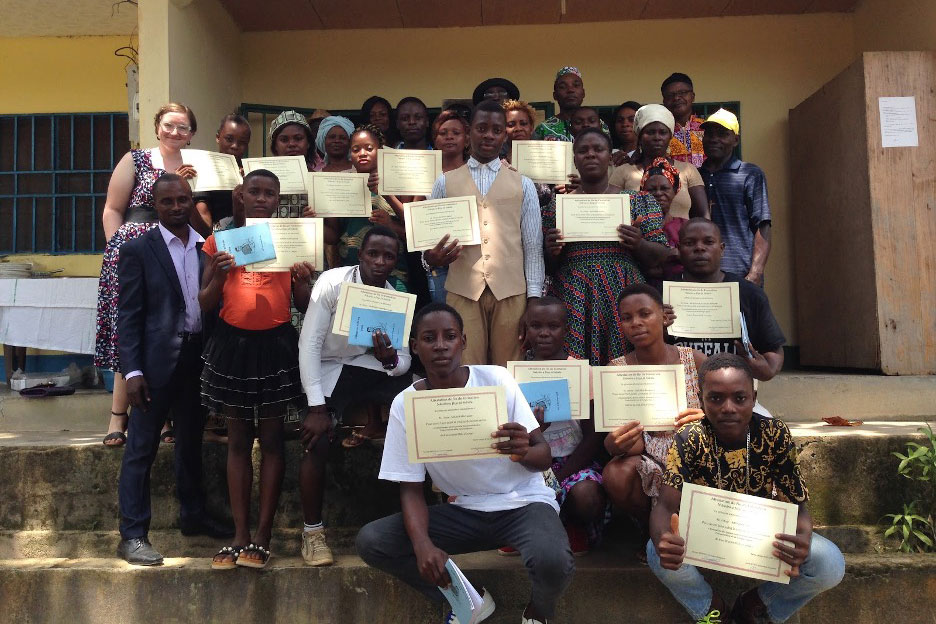
My name is Sammy Mbipite, and I am from Beyo, a coastal village in the far south of Cameroon. I am Iyasa (pronounced “ee-ya-sa”), and I am a linguist, passionate about my language and culture. I am the oldest of seven children from a hundred-percent Iyasa family. I love my language, and I have always wanted to work to support the Iyasa community. I was the first and only one in my family to go to university, where I studied linguistics. There I found the desire, the love, and the will to find ways to work for my language.
In 2018, my colleagues and I had the idea of holding a youth training workshop on Iyasa language documentation and revitalization. Since then, our association, Iyasa Éboó, has grown into something bigger than just a workshop, and I would like to share this story with you all.
Why did we need this workshop? It is important to understand the current situation of the Iyasa language and people. Around the world, thousands of languages are in danger of falling silent. In most cases, this endangerment happens over generations: over time, children and young people stop speaking the language, until the only people left who can speak are elders, and then, one day, no one at all.
This is the situation we are facing with Iyasa. Iyasa is a minority, endangered, and under-documented language spoken on the coast in Cameroon and Equatorial Guinea. It is a Bantu language (the same family as Swahili, Lingala, and many other large African languages). Most speakers live in Cameroon in the Campo Subdivision, Océan Division, South Region. Iyasa doesn’t have a large speaker population. We have only 2,000 to 3,000 people who can still speak the language well. In most villages and towns, children are growing up speaking French, not Iyasa. Young people, from about age fifteen to thirty, are at the brink of this language endangerment. Many of them can understand Iyasa and speak it to some degree, but they mostly speak French.
So I dreamed of starting a program to work with young people, the ones who are beginning to lose our language, and safeguard our culture and language. It started in 2018 with an awareness-raising and training workshop on language documentation and conservation. With my colleagues, Arnauld Djowe and Anna Belew, I planned a two-week workshop (funded by the Endangered Language Fund) to teach young people the basic skills to document, read, and write Iyasa. Our aim was to empower them to reconnect with their language and culture and to give them a way to become involved with language work.
Other work has been happening for our language. A few years ago, the Summer Institute of Linguistics (SIL), a Bible translating society, began a language development project called Comité d’Étude de la Langue Iyasa (CELI, or the Committee for the Study of the Iyasa Language). Through a great deal of work and dedication, CELI has developed an Iyasa alphabet booklet and a spelling guide, as well as a translation of some books in the Bible.
Despite the efforts and sacrifices made by some people, the general Iyasa population, especially young people, did not seem to join and participate in the CELI project. On the contrary, they felt sidelined, or even unwelcome. The work seemed to be only for SIL members, who were all elders, and who in turn felt that young people were irresponsible, insolent, and without any will or interest in language development. The intergenerational divide was palpable.
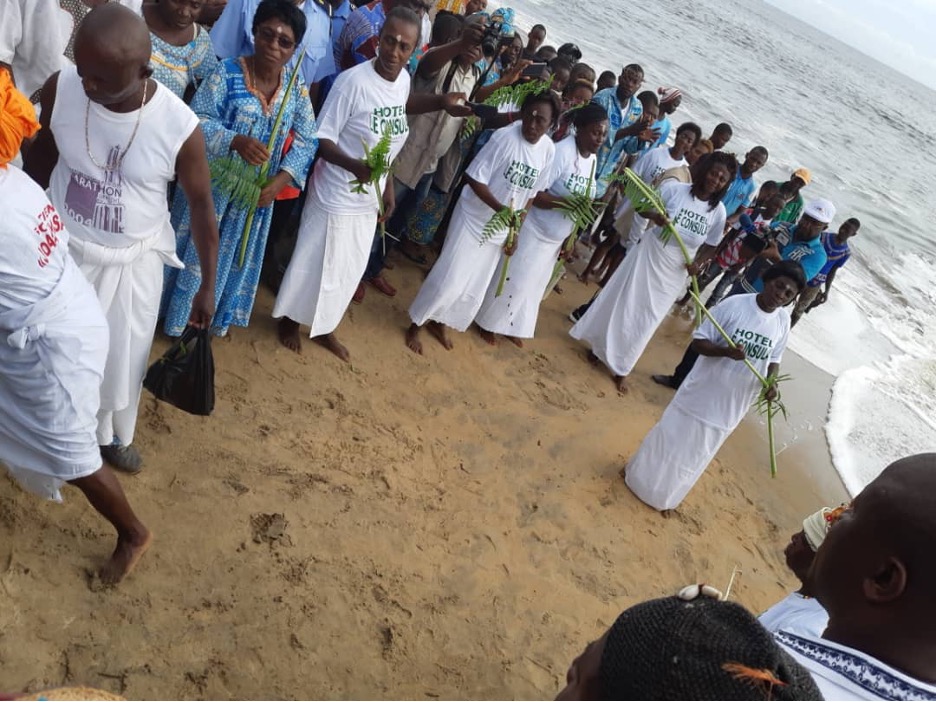
We wanted to make sure our program could make young people feel welcome. We especially wanted to empower them to choose how they worked on the language, instead of just telling them what to do. The first thing we needed was participants. In the month before the new youth workshop, Arnauld and I traveled around the Iyasa-speaking area, talking to parents and youths about this “summer school” and choosing seventeen young participants who were interested in Iyasa language and culture. We wanted to be sure we invited young people who were motivated and enthusiastic about learning, so that the workshop would succeed.
During this workshop, we discussed the state of danger their language was in, and the young learners took it to heart. They were moved to do something: they wanted to reconnect more with their language and work to protect it.
The students devoted themselves wholeheartedly to learning the methods offered by the workshop. These workshops included learning the alphabet and to write in Iyasa, how to use audio recorders to collect stories and knowledge, and how to use computers in order to transcribe and manage the data they collected.
None of the students had learned how to read or write Iyasa before, and they were thrilled to develop this skill. On the day we first learned the alphabet, they even ignored our lunch when it arrived, so they could stay in the classroom and practice writing Iyasa words on the chalkboard!
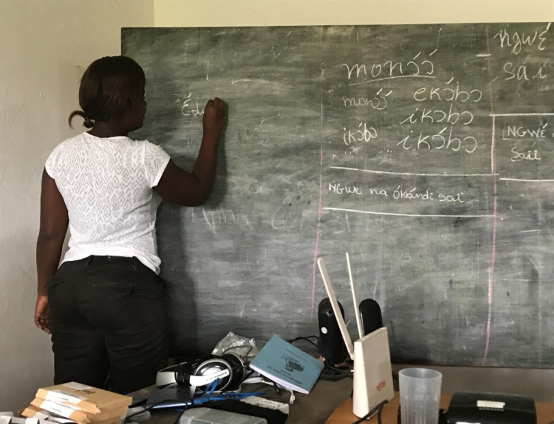
All of the students were also very excited to practice using computers. Some of them already had some computer skills, but others had little or no experience. Young people are always excited about technology, and these youths were no different. They learned all the computer skills much faster than we planned, and they were patient and kind with each other: more experienced students gladly helped the beginners with opening programs, using the mouse and keyboard, and so on. The students were truly committed to learning as a group, supporting their friends and classmates.
The whole workshop was a unique and captivating adventure. Every morning before the start of the session, someone came with a riddle or a question relating to the Iyasa culture. It could be an object for students to try to find its name in Iyasa or a traditional activity to describe. The students also challenged each other over the weekend to learn to make an Iyasa craft, like a raffia skirt, a toy boat with paddles, or a small traditional drum. Also, the learners returned home each day with homework and questions to ask their parents, grandparents, and neighbors, who gave them good information. They chose topics they were interested in, like traditional medicine, recipes, or songs, and made recordings with their family members. The motivation they brought to this work was even more beautiful. It gave the young people a chance to reconnect with their elder family members and have something to talk about and work on together.
“If we don’t do this, our children won’t be able to know what our ancestors did on earth,” Hermine Bothe, a participant in the workshop, said about her experience. “What I can say to other young people is to join the group so that they learn the little things that we too have learned.”
The workshop ended with a closing ceremony, to which all the parents and other relatives were invited, as well as the elder members of the language committee. We were a little nervous about this, since the language committee had been doubtful about youth getting involved in language work. But the elder members were proud of the work the youth had done and amazed at all they had learned. They did not fail to encourage and congratulate the initiative and the resulting project.
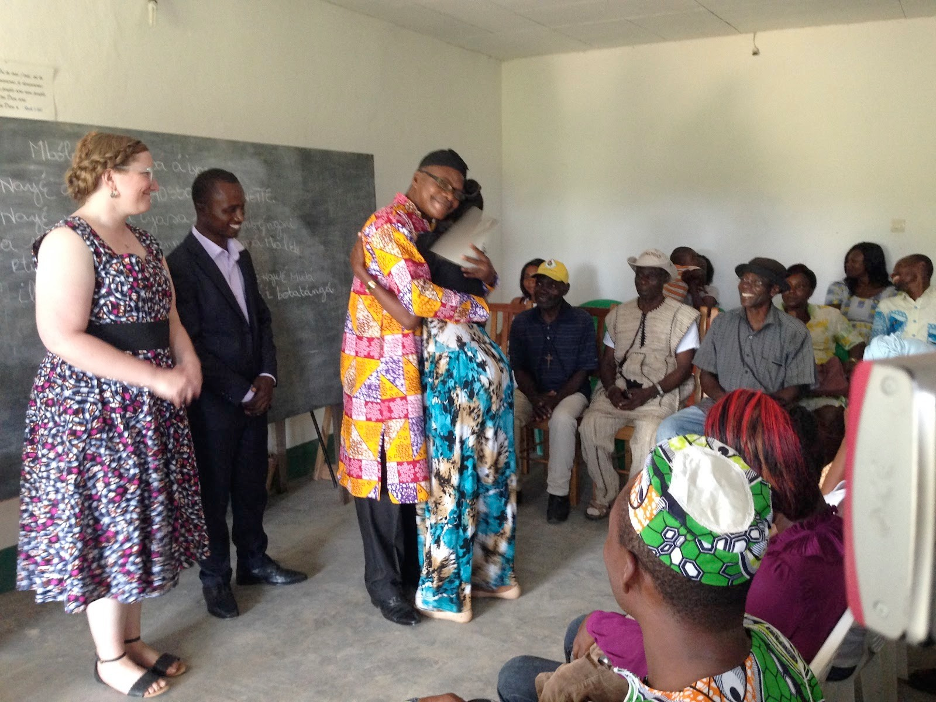
Touched and motivated by everything they learned during the workshop, the young students decided to form an association in order to be more effective within the community. They called it Iyasa Éboó (“Iyasa forward”). We started using the name to refer to our workshop as well. As a first concrete action, the students chose to unite their efforts to create a book on Iyasa traditional games.
“These games were already on the way out,” said Arnauld Ingride Djowe, president of Iyasa Éboó. “There are games that I knew when I was seven years old, and no one else is doing those games again. With the help of our promoters, our trainers, we are brought to remember our culture of our games which were already on the way to extinction. There are certain games that, when we redid them, I remembered those games that were already leaving, disappearing. So that’s a great gesture. I am very happy because these games today will no longer disappear. Our children, our grandsons tomorrow will recognize them through the documents that we are currently producing.”
To do this, it was necessary to seek the help and knowledge of the elders, because most young people today don’t know the traditional games. Unlike the earlier strained interactions between elders and youth at CELI, now the elders did not hesitate to help—quite the contrary! They gladly explained the different games, even helping them play the games in a concrete and practical way. It was one of the rare, but truly wonderful moments, when you could see real intergenerational communication and connection.
For the elders, the traditional games project offered nostalgia for their childhoods, but it also gave them real pleasure to bring their knowledge to the younger generation and to see them eager to learn more. The young people were proud to discover that there were such interesting things in their culture, like these games that made childhood happy and that brought the joy of being together.
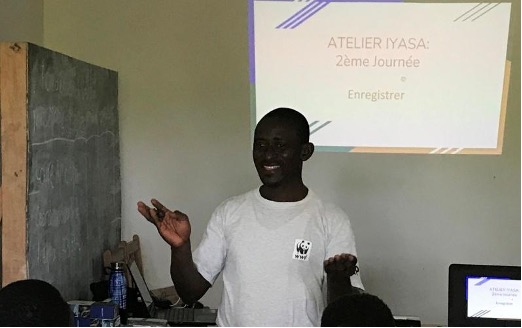
“These children deserve to be encouraged in what they are doing in this group of Iyasa Éboó,” said Adolphe Idjabe II, secondary school teacher and CELI member, who accompanied his younger brothers in the project. His interview was translated from Iyasa to English. “Why? Because they are the nursery that will help the others who come afterward learn the language, master it, and also understand the culture of our people.”
After the workshop ended, Iyasa Éboó continued. As the co-founder, I still mentor and supervise the students. Arnauld continued to organize meetings for the group at his home. Not only did the association continue, it grew! The students told their friends about what they had learned and the enjoyment of being together to learn about culture and language. Soon, the group had doubled in size, to thirty-five members. They also began hosting traditional game days at the beach, for young people to enjoy playing the games they were writing about, and spending time together speaking in Iyasa.
The Iyasa Éboó project was appreciated by the whole community but has still not reached the core of its objectives: namely, to see many young people producing books, video and audio recordings, and so on, in order to popularize and revitalize the Iyasa culture.
There are several reasons for this, but the main problem is poverty. All the young people come from poor families, and the search for daily bread is everyone’s priority. They are either students or fishermen. The problem of language development therefore becomes secondary, even though they are passionate about it. The poverty of the area causes other difficulties such as lack of access to printing, meeting space, and transportation between villages. And poverty feeds into the lack of confidence of some youth. Many young people do not take initiative because they are not sure of themselves; they do not feel up to it or do not believe they can achieve their goals. For many, this is because of their limited level of education.
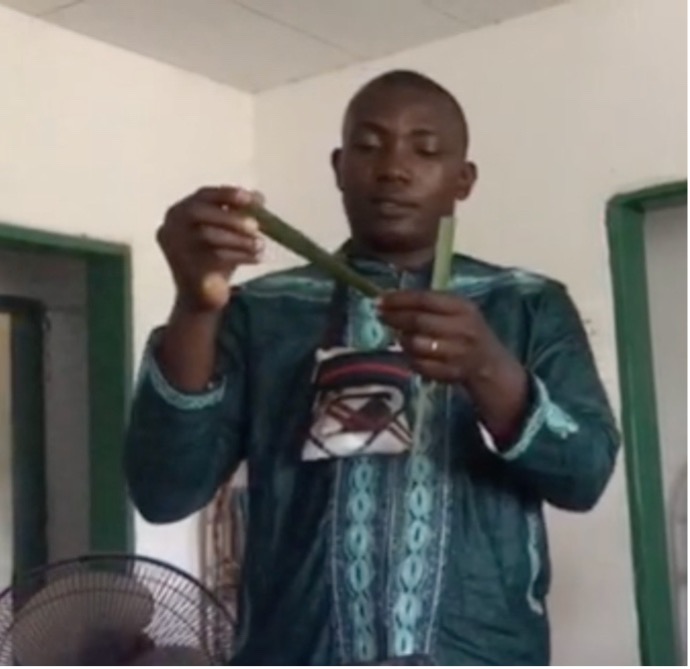
We hope the book on Iyasa traditional games will therefore be a kind of catalyst, something motivating. When these youth see that all of their work is benefiting the community, and that they have created something amazing with the skills and knowledge they gained, they will begin believing in themselves more.
It was also important to bring elders and youth together, to heal the relationship between these groups. Elders have the experience and knowledge of the Iyasa people and culture but often do not have enough strength to use their practical knowledge, especially of things like games. Young people have the strength and energy but need the knowledge. Young people also have more skills in new technology, especially after the workshop. These technologies are inescapable, so we should use them in service of our language and culture. Working together is a great benefit for all. We can achieve so much more together than apart.
We want to encourage more collective and individual work initiatives to uplift Iyasa language and culture, and we believe Iyasa Éboó is a wonderful model—not just for the Iyasa community, but for all other youth around the world who want to promote and reconnect with their languages.
About the Author
Sammy Mbipite is an Iyasa linguist who is passionate about his culture and language, and he is living in the traditional Iyasa way as a fisherman. He is co-founder of the Iyasa Éboó organization and holds a BA in linguistics and an MA in translation studies from Universite de Yaoundé I.
About the Center for Folklife and Cultural Heritage
The Center for Folklife and Cultural Heritage is a research and educational unit of the Smithsonian that promotes greater understanding and sustainability of cultural heritage across the United States and around the world through research, education, and community engagement. It produces the Smithsonian Folklife Festival, Smithsonian Folkways Recordings, exhibitions, symposia, publications, and educational materials. It also maintains the Ralph Rinzler Folklife Archives and Collections and manages cultural heritage initiatives around the world.